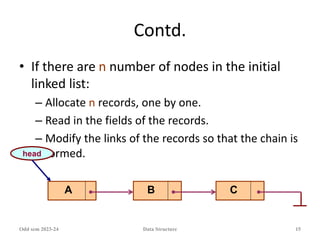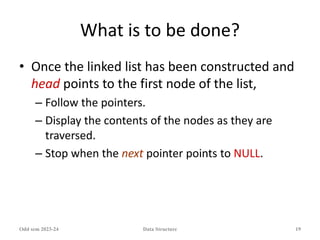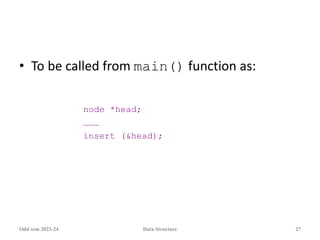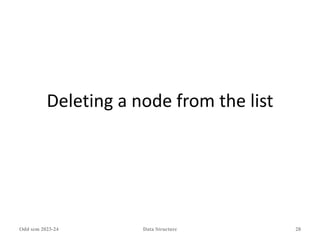linkedlist (1).ppt
- 1. Data Structure Chapter 2 Arrays and linked lists Odd sem 2023-24 Data Structure 1
- 2. Contents • Linked List, Linked List v/s Array, Types of Linked List • Singly Linked List, Circular Linked List, Doubly Linked List, • Operations on Singly Linked List and Doubly Linked List, • Singly Linked List Application • Polynomial Representation polynomial addition Odd sem 2023-24 Data Structure 2
- 3. Introduction to Linked List • A linked list is a data structure which can change during execution. – Successive elements are connected by pointers. – Last element points to NULL. – It can grow or shrink in size during execution of a program. – It can be made just as long as required. – It does not waste memory space. Odd sem 2023-24 Data Structure 3 A B C head
- 4. Introduction to Linked List • Keeping track of a linked list: – Must know the pointer to the first element of the list (called start, head, etc.). • Linked lists provide flexibility in allowing the items to be rearranged efficiently. – Insert an element. – Delete an element. Odd sem 2023-24 Data Structure 4
- 5. Array versus Linked Lists • Arrays are suitable for: – Inserting/deleting an element at the end. – Randomly accessing any element. – Searching the list for a particular value. • Linked lists are suitable for: – Inserting an element. – Deleting an element. – Applications where sequential access is required. – In situations where the number of elements cannot be predicted beforehand. Odd sem 2023-24 Data Structure 5
- 6. Types of Lists • Depending on the way in which the links are used to maintain adjacency, several different types of linked lists are possible. – Linear singly-linked list (or simply linear list) • One we have discussed so far. Odd sem 2023-24 Data Structure 6 A B C head
- 7. – Circular linked list • The pointer from the last element in the list points back to the first element. Odd sem 2023-24 Data Structure 7 A B C head
- 8. – Doubly linked list • Pointers exist between adjacent nodes in both directions. • The list can be traversed either forward or backward. • Usually two pointers are maintained to keep track of the list, head and tail. Odd sem 2023-24 Data Structure 8 A B C head tail
- 9. Basic Operations on a List • Creating a list • Traversing the list • Inserting an item in the list • Deleting an item from the list • Concatenating two lists into one Odd sem 2023-24 Data Structure 9
- 10. List is an Abstract Data Type • What is an abstract data type? – It is a data type defined by the user. – Typically more complex than simple data types like int, float, etc. • Why abstract? – Because details of the implementation are hidden. – When you do some operation on the list, say insert an element, you just call a function. – Details of how the list is implemented or how the insert function is written is no longer required. Odd sem 2023-24 Data Structure 10
- 11. Conceptual Idea Odd sem 2023-24 Data Structure 11 List implementation and the related functions Insert Delete Traverse
- 12. Example: Working with linked list • Consider the structure of a node as follows: struct stud { int roll; char name[25]; int age; struct stud *next; }; /* A user-defined data type called “node” */ typedef struct stud node; node *head; Odd sem 2023-24 Data Structure 12
- 13. Creating a List Odd sem 2023-24 Data Structure 13
- 14. How to begin? • To start with, we have to create a node (the first node), and make head point to it. head = (node *) malloc(sizeof(node)); Odd sem 2023-24 Data Structure 14 head age name roll next
- 15. Contd. • If there are n number of nodes in the initial linked list: – Allocate n records, one by one. – Read in the fields of the records. – Modify the links of the records so that the chain is formed. Odd sem 2023-24 Data Structure 15 A B C head
- 16. node *create_list() { int k, n; node *p, *head; printf ("n How many elements to enter?"); scanf ("%d", &n); for (k=0; k<n; k++) { if (k == 0) { head = (node *) malloc(sizeof(node)); p = head; } else { p->next = (node *) malloc(sizeof(node)); p = p->next; } scanf ("%d %s %d", &p->roll, p->name, &p->age); } p->next = NULL; return (head); } Odd sem 2023-24 Data Structure 16
- 17. • To be called from main() function as: node *head; ……… head = create_list(); Odd sem 2023-24 Data Structure 17
- 18. Traversing the List Odd sem 2023-24 Data Structure 18
- 19. What is to be done? • Once the linked list has been constructed and head points to the first node of the list, – Follow the pointers. – Display the contents of the nodes as they are traversed. – Stop when the next pointer points to NULL. Odd sem 2023-24 Data Structure 19
- 20. void display (node *head) { int count = 1; node *p; p = head; while (p != NULL) { printf ("nNode %d: %d %s %d", count, p->roll, p->name, p->age); count++; p = p->next; } printf ("n"); } Odd sem 2023-24 Data Structure 20
- 21. • To be called from main() function as: node *head; ……… display (head); Odd sem 2023-24 Data Structure 21
- 22. Inserting a Node in a List Odd sem 2023-24 Data Structure 22
- 23. How to do? • The problem is to insert a node before a specified node. – Specified means some value is given for the node (called key). – In this example, we consider it to be roll. • Convention followed: – If the value of roll is given as negative, the node will be inserted at the end of the list. Odd sem 2023-24 Data Structure 23
- 24. Contd. • When a node is added at the beginning, – Only one next pointer needs to be modified. • head is made to point to the new node. • New node points to the previously first element. • When a node is added at the end, – Two next pointers need to be modified. • Last node now points to the new node. • New node points to NULL. • When a node is added in the middle, – Two next pointers need to be modified. • Previous node now points to the new node. • New node points to the next node. Odd sem 2023-24 Data Structure 24
- 25. Odd sem 2023-24 Data Structure 25 void insert (node **head) { int k = 0, rno; node *p, *q, *new; new = (node *) malloc(sizeof(node)); printf ("nData to be inserted: "); scanf ("%d %s %d", &new->roll, new->name, &new->age); printf ("nInsert before roll (-ve for end):"); scanf ("%d", &rno); p = *head; if (p->roll == rno) /* At the beginning */ { new->next = p; *head = new; }
- 26. Odd sem 2023-24 Data Structure 26 else { while ((p != NULL) && (p->roll != rno)) { q = p; p = p->next; } if (p == NULL) /* At the end */ { q->next = new; new->next = NULL; } else if (p->roll == rno) /* In the middle */ { q->next = new; new->next = p; } } } The pointers q and p always point to consecutive nodes.
- 27. • To be called from main() function as: node *head; ……… insert (&head); Odd sem 2023-24 Data Structure 27
- 28. Deleting a node from the list Odd sem 2023-24 Data Structure 28
- 29. Illustration: Deletion Odd sem 2023-24 Data Structure 29 A B A B C C Item to be deleted curr tmp
- 30. Pseudo-code for deletion Odd sem 2023-24 Data Structure 30 typedef struct nd { struct item data; struct nd * next; } node; void delete(node *curr) { node * tmp; tmp=curr->next; curr->next=tmp->next; free(tmp); }
- 31. Illustration: Insertion Odd sem 2023-24 Data Structure 31 A A Item to be inserted X X A B C B C curr tmp
- 32. Pseudo-code for insertion Odd sem 2023-24 Data Structure 32 typedef struct nd { struct item data; struct nd * next; } node; void insert(node *curr) { node * tmp; tmp=(node *) malloc(sizeof(node)); tmp->next=curr->next; curr->next=tmp; }
- 33. What is to be done? • Here also we are required to delete a specified node. – Say, the node whose roll field is given. • Here also three conditions arise: – Deleting the first node. – Deleting the last node. – Deleting an intermediate node. Odd sem 2023-24 Data Structure 33
- 34. Odd sem 2023-24 Data Structure 34 void delete (node **head) { int rno; node *p, *q; printf ("nDelete for roll :"); scanf ("%d", &rno); p = *head; if (p->roll == rno) /* Delete the first element */ { *head = p->next; free (p); }
- 35. Odd sem 2023-24 Data Structure 35 else { while ((p != NULL) && (p->roll != rno)) { q = p; p = p->next; } if (p == NULL) /* Element not found */ printf ("nNo match :: deletion failed"); else if (p->roll == rno) /* Delete any other element */ { q->next = p->next; free (p); } } }
- 36. In essence ... • For insertion: – A record is created holding the new item. – The next pointer of the new record is set to link it to the item which is to follow it in the list. – The next pointer of the item which is to precede it must be modified to point to the new item. • For deletion: – The next pointer of the item immediately preceding the one to be deleted is altered, and made to point to the item following the deleted item. Odd sem 2023-24 Data Structure 36
- 37. Few Exercises to Try Out • Write a function to: – Concatenate two given list into one big list. node *concatenate (node *head1, node *head2); – Insert an element in a linked list in sorted order. The function will be called for every element to be inserted. void insert_sorted (node **head, node *element); – Always insert elements at one end, and delete elements from the other end (first-in first-out QUEUE). void insert_q (node **head, node *element) node *delete_q (node **head) /* Return the deleted node */ Odd sem 2023-24 Data Structure 37
- 38. A First-in First-out (FIFO) List Odd sem 2023-24 Data Structure 38 Also called a QUEUE In Out A C B A B
- 39. A Last-in First-out (LIFO) List Odd sem 2023-24 Data Structure 39 In Out A B C C B Also called a STACK
- 40. Abstract Data Types Odd sem 2023-24 Data Structure 40
- 41. Example 1 :: Complex numbers struct cplx { float re; float im; } typedef struct cplx complex; complex *add (complex a, complex b); complex *sub (complex a, complex b); complex *mul (complex a, complex b); complex *div (complex a, complex b); complex *read(); void print (complex a); Odd sem 2023-24 Data Structure 41 Structure definition Function prototypes
- 42. Odd sem 2023-24 Data Structure 42 Complex Number add print mul sub read div
- 43. Example 2 :: Set manipulation struct node { int element; struct node *next; } typedef struct node set; set *union (set a, set b); set *intersect (set a, set b); set *minus (set a, set b); void insert (set a, int x); void delete (set a, int x); int size (set a); Odd sem 2023-24 Data Structure 43 Structure definition Function prototypes
- 44. Odd sem 2023-24 Data Structure 44 Set union size minus intersect delete insert
- 45. Example 3 :: Last-In-First-Out STACK Assume:: stack contains integer elements void push (stack *s, int element); /* Insert an element in the stack */ int pop (stack *s); /* Remove and return the top element */ void create (stack *s); /* Create a new stack */ int isempty (stack *s); /* Check if stack is empty */ int isfull (stack *s); /* Check if stack is full */ Odd sem 2023-24 Data Structure 45
- 46. Odd sem 2023-24 Data Structure 46 STACK push create pop isfull isempty
- 47. Contd. • We shall look into two different ways of implementing stack: – Using arrays – Using linked list Odd sem 2023-24 Data Structure 47
- 48. Example 4 :: First-In-First-Out QUEUE Assume:: queue contains integer elements void enqueue (queue *q, int element); /* Insert an element in the queue */ int dequeue (queue *q); /* Remove an element from the queue */ queue *create(); /* Create a new queue */ int isempty (queue *q); /* Check if queue is empty */ int size (queue *q); /* Return the no. of elements in queue */ Odd sem 2023-24 Data Structure 48
- 49. Odd sem 2023-24 Data Structure 49 QUEUE enqueue create dequeue size isempty
- 50. Stack Implementations: Using Array and Linked List Odd sem 2023-24 Data Structure 50
- 51. STACK USING ARRAY Odd sem 2023-24 Data Structure 51 top top PUSH
- 52. STACK USING ARRAY Odd sem 2023-24 Data Structure 52 top top POP
- 53. Stack: Linked List Structure Odd sem 2023-24 Data Structure 53 top PUSH OPERATION
- 54. Stack: Linked List Structure Odd sem 2023-24 Data Structure 54 top POP OPERATION
- 55. Basic Idea • In the array implementation, we would: – Declare an array of fixed size (which determines the maximum size of the stack). – Keep a variable which always points to the “top” of the stack. • Contains the array index of the “top” element. • In the linked list implementation, we would: – Maintain the stack as a linked list. – A pointer variable top points to the start of the list. – The first element of the linked list is considered as the stack top. Odd sem 2023-24 Data Structure 56
- 56. Declaration #define MAXSIZE 100 struct lifo { int st[MAXSIZE]; int top; }; typedef struct lifo stack; stack s; struct lifo { int value; struct lifo *next; }; typedef struct lifo stack; stack *top; Odd sem 2023-24 Data Structure 57 ARRAY LINKED LIST
- 57. Stack Creation void create (stack *s) { s->top = -1; /* s->top points to last element pushed in; initially -1 */ } void create (stack **top) { *top = NULL; /* top points to NULL, indicating empty stack */ } Odd sem 2023-24 Data Structure 58 ARRAY LINKED LIST
- 58. Pushing an element into the stack void push (stack *s, int element) { if (s->top == (MAXSIZE-1)) { printf (“n Stack overflow”); exit(-1); } else { s->top ++; s->st[s->top] = element; } } Odd sem 2023-24 Data Structure 59 ARRAY
- 59. void push (stack **top, int element) { stack *new; new = (stack *) malloc(sizeof(stack)); if (new == NULL) { printf (“n Stack is full”); exit(-1); } new->value = element; new->next = *top; *top = new; } Odd sem 2023-24 Data Structure 60 LINKED LIST
- 60. Popping an element from the stack int pop (stack *s) { if (s->top == -1) { printf (“n Stack underflow”); exit(-1); } else { return (s->st[s->top--]); } } Odd sem 2023-24 Data Structure 61 ARRAY
- 61. int pop (stack **top) { int t; stack *p; if (*top == NULL) { printf (“n Stack is empty”); exit(-1); } else { t = (*top)->value; p = *top; *top = (*top)->next; free (p); return t; } } Odd sem 2023-24 Data Structure 62 LINKED LIST
- 62. Checking for stack empty int isempty (stack *s) { if (s->top == -1) return 1; else return (0); } int isempty (stack *top) { if (top == NULL) return (1); else return (0); } Odd sem 2023-24 Data Structure 63 ARRAY LINKED LIST
- 63. Checking for stack full int isfull (stack *s) { if (s->top == (MAXSIZE–1)) return 1; else return (0); } • Not required for linked list implementation. • In the push() function, we can check the return value of malloc(). – If -1, then memory cannot be allocated. Odd sem 2023-24 Data Structure 64 ARRAY LINKED LIST
- 64. Example main function :: array #include <stdio.h> #define MAXSIZE 100 struct lifo { int st[MAXSIZE]; int top; }; typedef struct lifo stack; main() { stack A, B; create(&A); create(&B); push(&A,10); push(&A,20); push(&A,30); push(&B,100); push(&B,5); printf (“%d %d”, pop(&A), pop(&B)); push (&A, pop(&B)); if (isempty(&B)) printf (“n B is empty”); } Odd sem 2023-24 Data Structure 65
- 65. Example main function :: linked list #include <stdio.h> struct lifo { int value; struct lifo *next; }; typedef struct lifo stack; main() { stack *A, *B; create(&A); create(&B); push(&A,10); push(&A,20); push(&A,30); push(&B,100); push(&B,5); printf (“%d %d”, pop(&A), pop(&B)); push (&A, pop(&B)); if (isempty(B)) printf (“n B is empty”); } Odd sem 2023-24 Data Structure 66
- 66. Queue Implementation using Linked List Odd sem 2023-24 Data Structure 67
- 67. Basic Idea • Basic idea: – Create a linked list to which items would be added to one end and deleted from the other end. – Two pointers will be maintained: • One pointing to the beginning of the list (point from where elements will be deleted). • Another pointing to the end of the list (point where new elements will be inserted). Odd sem 2023-24 Data Structure 68 Front Rear DELETION INSERTION
- 68. QUEUE: LINKED LIST STRUCTURE Odd sem 2023-24 Data Structure 69 front rear ENQUEUE
- 69. QUEUE: LINKED LIST STRUCTURE Odd sem 2023-24 Data Structure 70 front rear DEQUEUE
- 70. QUEUE using Linked List Odd sem 2023-24 Data Structure 71 #include <stdio.h> #include <stdlib.h> #include <string.h> struct node{ char name[30]; struct node *next; }; typedef struct node _QNODE; typedef struct { _QNODE *queue_front, *queue_rear; } _QUEUE;
- 71. Odd sem 2023-24 Data Structure 72 _QNODE *enqueue (_QUEUE *q, char x[]) { _QNODE *temp; temp= (_QNODE *) malloc (sizeof(_QNODE)); if (temp==NULL){ printf(“Bad allocation n"); return NULL; } strcpy(temp->name,x); temp->next=NULL; if(q->queue_rear==NULL) { q->queue_rear=temp; q->queue_front= q->queue_rear; } else { q->queue_rear->next=temp; q->queue_rear=temp; } return(q->queue_rear); }
- 72. Odd sem 2023-24 Data Structure 73 char *dequeue(_QUEUE *q,char x[]) { _QNODE *temp_pnt; if(q->queue_front==NULL){ q->queue_rear=NULL; printf("Queue is empty n"); return(NULL); } else{ strcpy(x,q->queue_front->name); temp_pnt=q->queue_front; q->queue_front= q->queue_front->next; free(temp_pnt); if(q->queue_front==NULL) q->queue_rear=NULL; return(x); } }
- 73. Odd sem 2023-24 Data Structure 74 void init_queue(_QUEUE *q) { q->queue_front= q->queue_rear=NULL; } int isEmpty(_QUEUE *q) { if(q==NULL) return 1; else return 0; }
- 74. Odd sem 2023-24 Data Structure 75 main() { int i,j; char command[5],val[30]; _QUEUE q; init_queue(&q); command[0]='0'; printf("For entering a name use 'enter <name>'n"); printf("For deleting use 'delete' n"); printf("To end the session use 'bye' n"); while(strcmp(command,"bye")){ scanf("%s",command);
- 75. Odd sem 2023-24 Data Structure 76 if(!strcmp(command,"enter")) { scanf("%s",val); if((enqueue(&q,val)==NULL)) printf("No more pushing please n"); else printf("Name entered %s n",val); } if(!strcmp(command,"delete")) { if(!isEmpty(&q)) printf("%s n",dequeue(&q,val)); else printf("Name deleted %s n",val); } } /* while */ printf("End session n"); }
- 76. Problem With Array Implementation Odd sem 2023-24 Data Structure 77 front rear rear ENQUEUE front DEQUEUE Effective queuing storage area of array gets reduced. Use of circular array indexing 0 N
- 77. Queue: Example with Array Implementation Odd sem 2023-24 Data Structure 78 typedef struct { char name[30]; } _ELEMENT; typedef struct { _ELEMENT q_elem[MAX_SIZE]; int rear; int front; int full,empty; } _QUEUE; #define MAX_SIZE 100
- 78. Queue Example: Contd. Odd sem 2023-24 Data Structure 79 void init_queue(_QUEUE *q) {q->rear= q->front= 0; q->full=0; q->empty=1; } int IsFull(_QUEUE *q) {return(q->full);} int IsEmpty(_QUEUE *q) {return(q->empty);}
- 79. Queue Example: Contd. Odd sem 2023-24 Data Structure 80 void AddQ(_QUEUE *q, _ELEMENT ob) { if(IsFull(q)) {printf("Queue is Full n"); return;} q->rear=(q->rear+1)%(MAX_SIZE); q->q_elem[q->rear]=ob; if(q->front==q->rear) q->full=1; else q->full=0; q->empty=0; return; }
- 80. Queue Example: Contd. Odd sem 2023-24 Data Structure 81 _ELEMENT DeleteQ(_QUEUE *q) { _ELEMENT temp; temp.name[0]='0'; if(IsEmpty(q)) {printf("Queue is EMPTYn");return(temp);} q->front=(q->front+1)%(MAX_SIZE); temp=q->q_elem[q->front]; if(q->rear==q->front) q->empty=1; else q->empty=0; q->full=0; return(temp); }
- 81. Queue Example: Contd. Odd sem 2023-24 Data Structure 82 main() { int i,j; char command[5]; _ELEMENT ob; _QUEUE A; init_queue(&A); command[0]='0'; printf("For adding a name use 'add [name]'n"); printf("For deleting use 'delete' n"); printf("To end the session use 'bye' n"); #include <stdio.h> #include <stdlib.h> #include <string.h>
- 82. Queue Example: Contd. Odd sem 2023-24 Data Structure 83 while (strcmp(command,"bye")!=0){ scanf("%s",command); if(strcmp(command,"add")==0) { scanf("%s",ob.name); if (IsFull(&A)) printf("No more insertion please n"); else { AddQ(&A,ob); printf("Name inserted %s n",ob.name); } }
- 83. Queue Example: Contd. Odd sem 2023-24 Data Structure 84 if (strcmp(command,"delete")==0) { if (IsEmpty(&A)) printf("Queue is empty n"); else { ob=DeleteQ(&A); printf("Name deleted %s n",ob.name); } } } /* End of while */ printf("End session n"); }











![Example: Working with linked list
• Consider the structure of a node as follows:
struct stud {
int roll;
char name[25];
int age;
struct stud *next;
};
/* A user-defined data type called “node” */
typedef struct stud node;
node *head;
Odd sem 2023-24 Data Structure 12](https://image.slidesharecdn.com/linkedlist1-230810104555-0fbab50c/85/linkedlist-1-ppt-12-320.jpg)











































![Declaration
#define MAXSIZE 100
struct lifo
{
int st[MAXSIZE];
int top;
};
typedef struct lifo
stack;
stack s;
struct lifo
{
int value;
struct lifo *next;
};
typedef struct lifo
stack;
stack *top;
Odd sem 2023-24 Data Structure 57
ARRAY LINKED LIST](https://image.slidesharecdn.com/linkedlist1-230810104555-0fbab50c/85/linkedlist-1-ppt-56-320.jpg)

![Pushing an element into the stack
void push (stack *s, int element)
{
if (s->top == (MAXSIZE-1))
{
printf (“n Stack overflow”);
exit(-1);
}
else
{
s->top ++;
s->st[s->top] = element;
}
}
Odd sem 2023-24 Data Structure 59
ARRAY](https://image.slidesharecdn.com/linkedlist1-230810104555-0fbab50c/85/linkedlist-1-ppt-58-320.jpg)

![Popping an element from the stack
int pop (stack *s)
{
if (s->top == -1)
{
printf (“n Stack underflow”);
exit(-1);
}
else
{
return (s->st[s->top--]);
}
}
Odd sem 2023-24 Data Structure 61
ARRAY](https://image.slidesharecdn.com/linkedlist1-230810104555-0fbab50c/85/linkedlist-1-ppt-60-320.jpg)



![Example main function :: array
#include <stdio.h>
#define MAXSIZE 100
struct lifo
{
int st[MAXSIZE];
int top;
};
typedef struct lifo stack;
main()
{
stack A, B;
create(&A); create(&B);
push(&A,10);
push(&A,20);
push(&A,30);
push(&B,100); push(&B,5);
printf (“%d %d”, pop(&A),
pop(&B));
push (&A, pop(&B));
if (isempty(&B))
printf (“n B is empty”);
}
Odd sem 2023-24 Data Structure 65](https://image.slidesharecdn.com/linkedlist1-230810104555-0fbab50c/85/linkedlist-1-ppt-64-320.jpg)





![QUEUE using Linked List
Odd sem 2023-24 Data Structure 71
#include <stdio.h>
#include <stdlib.h>
#include <string.h>
struct node{
char name[30];
struct node *next;
};
typedef struct node _QNODE;
typedef struct {
_QNODE *queue_front, *queue_rear;
} _QUEUE;](https://image.slidesharecdn.com/linkedlist1-230810104555-0fbab50c/85/linkedlist-1-ppt-70-320.jpg)
![Odd sem 2023-24 Data Structure 72
_QNODE *enqueue (_QUEUE *q, char x[])
{
_QNODE *temp;
temp= (_QNODE *)
malloc (sizeof(_QNODE));
if (temp==NULL){
printf(“Bad allocation n");
return NULL;
}
strcpy(temp->name,x);
temp->next=NULL;
if(q->queue_rear==NULL)
{
q->queue_rear=temp;
q->queue_front=
q->queue_rear;
}
else
{
q->queue_rear->next=temp;
q->queue_rear=temp;
}
return(q->queue_rear);
}](https://image.slidesharecdn.com/linkedlist1-230810104555-0fbab50c/85/linkedlist-1-ppt-71-320.jpg)
![Odd sem 2023-24 Data Structure 73
char *dequeue(_QUEUE *q,char x[])
{
_QNODE *temp_pnt;
if(q->queue_front==NULL){
q->queue_rear=NULL;
printf("Queue is empty n");
return(NULL);
}
else{
strcpy(x,q->queue_front->name);
temp_pnt=q->queue_front;
q->queue_front=
q->queue_front->next;
free(temp_pnt);
if(q->queue_front==NULL)
q->queue_rear=NULL;
return(x);
}
}](https://image.slidesharecdn.com/linkedlist1-230810104555-0fbab50c/85/linkedlist-1-ppt-72-320.jpg)

![Odd sem 2023-24 Data Structure 75
main()
{
int i,j;
char command[5],val[30];
_QUEUE q;
init_queue(&q);
command[0]='0';
printf("For entering a name use 'enter <name>'n");
printf("For deleting use 'delete' n");
printf("To end the session use 'bye' n");
while(strcmp(command,"bye")){
scanf("%s",command);](https://image.slidesharecdn.com/linkedlist1-230810104555-0fbab50c/85/linkedlist-1-ppt-74-320.jpg)


![Queue: Example with Array Implementation
Odd sem 2023-24 Data Structure 78
typedef struct { char name[30];
} _ELEMENT;
typedef struct {
_ELEMENT q_elem[MAX_SIZE];
int rear;
int front;
int full,empty;
} _QUEUE;
#define MAX_SIZE 100](https://image.slidesharecdn.com/linkedlist1-230810104555-0fbab50c/85/linkedlist-1-ppt-77-320.jpg)

![Queue Example: Contd.
Odd sem 2023-24 Data Structure 80
void AddQ(_QUEUE *q, _ELEMENT ob)
{
if(IsFull(q)) {printf("Queue is Full n"); return;}
q->rear=(q->rear+1)%(MAX_SIZE);
q->q_elem[q->rear]=ob;
if(q->front==q->rear) q->full=1; else q->full=0;
q->empty=0;
return;
}](https://image.slidesharecdn.com/linkedlist1-230810104555-0fbab50c/85/linkedlist-1-ppt-79-320.jpg)
![Queue Example: Contd.
Odd sem 2023-24 Data Structure 81
_ELEMENT DeleteQ(_QUEUE *q)
{
_ELEMENT temp;
temp.name[0]='0';
if(IsEmpty(q)) {printf("Queue is EMPTYn");return(temp);}
q->front=(q->front+1)%(MAX_SIZE);
temp=q->q_elem[q->front];
if(q->rear==q->front) q->empty=1; else q->empty=0;
q->full=0;
return(temp);
}](https://image.slidesharecdn.com/linkedlist1-230810104555-0fbab50c/85/linkedlist-1-ppt-80-320.jpg)
![Queue Example: Contd.
Odd sem 2023-24 Data Structure 82
main()
{
int i,j;
char command[5];
_ELEMENT ob;
_QUEUE A;
init_queue(&A);
command[0]='0';
printf("For adding a name use 'add [name]'n");
printf("For deleting use 'delete' n");
printf("To end the session use 'bye' n");
#include <stdio.h>
#include <stdlib.h>
#include <string.h>](https://image.slidesharecdn.com/linkedlist1-230810104555-0fbab50c/85/linkedlist-1-ppt-81-320.jpg)

